This post is a comprehensive review of healthy, non-offgassing countertop options.
We have to look at the materials themselves as well as the sealers if they require one.
Almost all the countertop options here can also be used as non-toxic vanity tops in a bathroom.
For the rest of a non-toxic kitchen series, see dedicated posts on:
This article contains affiliate links, upon purchase I make a small commission at no extra cost to you.
Non-Toxic Countertops
Granite and Marble Counters
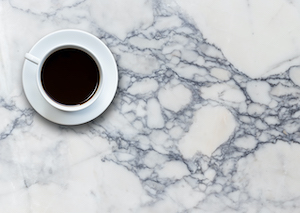
Granite and marble are often treated with a sealant and resin before it makes it to your home.
The downside of most types of granite and marble is that they need to be resealed every year or two and you need to find a sealer that is acceptable to you.
Light-colored porous stones must be sealed with a synthetic sealer, SimpleCoat is one of two I have found that is free of PFAS and is 0-VOC.
Walnut Oil works great if the stones are darker colors or warm-toned colors and are not glossy. I tested and was very happy with this sealer because it’s all-natural and it performed better in my tests than many synthetics.
Ubatuba granite and many other dark stones like some dense granites and some slate do not need a sealer which is a major plus side.
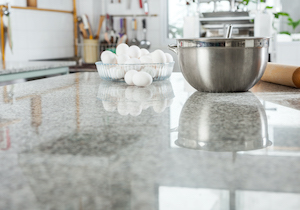
Granite and Radon
Natural stone can contain trace amounts of radioactive elements like uranium and thorium which produce the gas radon and can emit small amounts of beta and gamma radiation. The EPA does not consider this above the earth’s natural background level of radiation.
Granite is more likely than other types of stone slabs to contain these elements, but not every slab will contain them.
Underlayment/Install
Granite and marble don’t always need plywood as an underlayment, it depends on the thickness. You could also try using a different type of underlayment.
Epoxy glue is used on the seams, which does cure quickly.
Cost: Marble $100 to $200 per square foot. Granite $75 to $175 per square foot.
Other Natural Stone Counters
Soapstone
Soapstone is a good natural option that is dense and doesn’t require sealing. It is usually treated with mineral oil to keep the color, but it can be treated with Milk Paint Soapstone Sealer a natural walnut oil with carnauba wax.
Cost: $70 to $100 per square foot
Quartzite
Quartzite is a stone that is often very dense, denser than granite, and may not require a sealer. Quartzite from Home Depot has a StoneMark sealant on it which is a thin film attached to it and that has a very long warranty. I did not pick up any odor from the sample I got but I have questions about how that film will hold up.
Limestone
Limestone is a relatively soft and porous stone compared to many of the other options. It can also be sealed with the walnut sealer, though you should check for yellowing. You may need to use a non-toxic synthetic sealant to keep the true color.
Cost: $60 to $80 per square foot
Solid Slate
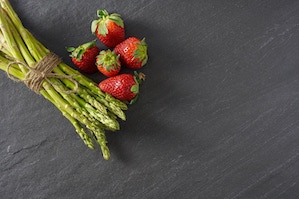
With solid slate find out if a sealant has been used. You can use Milk Paint Walnut sealer on raw slate.
Some slate is dense enough to not require a sealer.
Cost: $50 to $75 per square foot
Walnut Oil (with carnauba wax) is the preferred natural oil for sealing honed indoor stone. It’s also highly tolerable for the chemically sensitive. If you buy hemp or walnut through the Milk Paint company you can get 10% off with code mychemicalfreehouse.
Quartz Counters (Engineered Stone)
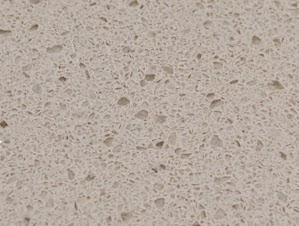
I used Cambria Quartz in my tiny home and it’s absolutely beautiful.
Quartz is made of ground quartz (real stone), pigment, and a binder, usually polyester resin.
They claim that the final product is fully cured (no VOCs), but it did have a very minor offgassing odor for the first few days. After that, I found it completely safe.
Silestone is the one brand that contains an antimicrobial, Microban mixed into the structure. I’m not sure why that would be necessary. I would personally avoid Microban.
I did not use any glue to fasten it. Epoxy glues are used if you have seams. This offgasses quickly.
It is a long-lasting non-porous material that doesn’t need a sealer though I have found it prone to staining from red wine, black tea, rust, paint, and packaging dyes.
If you are sensitive to chemicals do not allow them to spray a chemical cleaner on it after they cut it and before they install it. Stay away from the dust while they are cutting it.
Cost: $55 to $155 per square foot. The price is comparable to marble, but more than granite.
Sintered Stone Countertops (Porcelain)
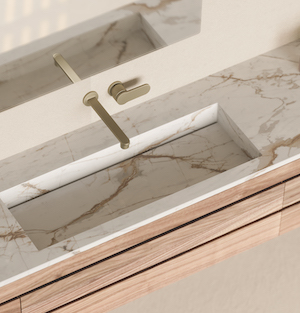
Sintered stone is made from the natural raw materials found in glass, porcelain, and quartz, formed under extremely high heat and pressure. There is no synthetic polyester resin and no offgassing in sintered stone.
It is denser than regular quartz and is virtually impossible to stain (no sealer needed).
You can also put hot pans directly on it.
Dekton (pictured) is made from natural quartz stone, porcelain, and glass compressed under high pressure and heat.
Corian Endura is made of sand, clay, and feldspar and pressed together with heat.
Neolith is another sintered stone (also called porcelain) made of granite minerals, such as feldspar and pure quartz, minerals from silica and glass, and natural oxides.
These are preferable to quartz for those extremely sensitive to chemicals as there is no offgassing here.
Paper Composite
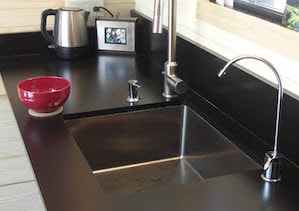
PaperStone and Richlite (pictured) are paper-based and lightweight (ideal for trailers and tiny houses!)
They are made with phenol-formaldehyde as the main resin. (Though there is some misrepresentation by some vendors, it’s not hard to find the documents for Richlite and PaperStone indicating formaldehyde as the resin.)
Both brands claim the final product contains no detectable formaldehyde and emits no VOCs.
I have found that these brands do smell like formaldehyde when brand new, but they do make good progress rather quickly, depending on the thickness – a thin piece only took a few days and a thicker slab took a few weeks. I have to have my nose up to the product to pick up the formaldehyde.
I would use this product in my home though, I love how it looks and the offgassing is minor and does come to completion.
Richlite is made with new paper, PaperStone is made with recycled paper. PaperRock is an Australian brand making this same type of benchtop (as they call countertops there).
Installation and Maintenance
If you have seams, they are glued with epoxy glue just like stone counters.
You can seal PaperStone with Soapstone sealer. Richlite also makes their own oil/wax as well as a polyurethane finish.
Costs: $45 to $100 per square foot. You can install them yourself which is a huge upside that can really bring the cost down.
Glass & Concrete

Recycled glass counters come in different types. One made with resin is very similar to quartz and is also considered just as safe.
The other type uses cement as the base for the glass.
Icestone is a brand that makes cement & glass countertops – they claim zero VOC. It needs a stone sealer.
Vetrazzo is another brand that makes glass and concrete countertops.
Cost: $50 to $100 per square foot
Solid Surface Counters – Plastic Resin-Based
Solid-surface countertops are made from alumina trihydrate (ATH) as the filler, acrylic or polyester as the resin (binder), and pigments for color. Many of the designs are very hard to distinguish from quartz.
When the material is newly produced it has an odor similar to cured polyether caulking, this smell does not last forever.
Some brands contain anti-microbials.
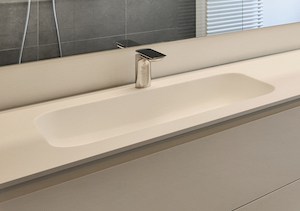
Corian Solid Surface is made from an acrylic polymer and alumina trihydrate. It is GreenGuard Gold certified.
The integrated sinks are a cool feature of Corian (pictured).
Swanstone is also acrylic and alumina trihydrate. Cost: $42 – $65 per square foot
Avonite makes an 100% acrylic option that is GreenGuard certified.
Durat is appealing because it might be the lightest option for a trailer or tiny house. It is low-VOC, and based on polyester and acrylic (made partly from recycled cell phones).
Other Plastic Based Countertops
Another plastic option that is super light is Metem, which is recycled HDPE and claims no offgassing. I tested it out and found it very safe.
Concrete Countertops
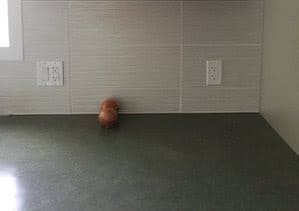
This is a non-toxic countertop mix that does not contain fly ash, vinyl, or latex.
Fly ash is not ideal in concrete products as it contains toxic metals and can contain radioactive elements.
You could use white sand, pigments, and other non-toxic concrete stains to get different looks. Colorants should be non-aniline dyes free of toxic metals.
Mineral pigments free of toxic metals can be used. Davis Colors and Prarie sell pigments and colorants.
Seal with AFM Safecoat 2K Pro Urethane from GDC, Walnut oil Sealer, or Tung Oil.
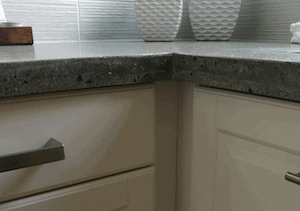
Odies Oil and Daddy Vans also make non-toxic oil and wax concrete sealers, but they do not disclose all of their ingredients.
Concrete countertops need to be resealed regularly just like real stone.
This can be a very affordable option, especially if you DIY. There are lots of videos on how to make these, but a DIY concrete counter could be prone to cracks if you are not careful, which are difficult to repair in a non-toxic way.
Cost: $75 to $150 per square foot (if you don’t DIY)
Stainless Steel, Aluminum and Copper, & Zinc Counters

Wood is typically used as the underlayment for residential metal countertops.
Copper normally is coated in a sealer but you can leave it raw if you don’t mind the color change.
Stainless steel can look very modern and is one of the most inert safe options for the chemically sensitive.
Stainless steel, unlike raw steel, does not need to be sealed. It will only rust with prolonged water standing. They usually don’t have seams. 16- to 18-gauge steel is common in residential applications, while 14 is common in commercial kitchens.
Zinc can be used as well, and left to patina like copper, but it’s far more expensive.
Costs: Stainless is $80 to $250 per square foot. Zinc costs $150 to $200 per square foot.
A ground fault interrupter is used as an extra safety measure.
Solid Wood Counters
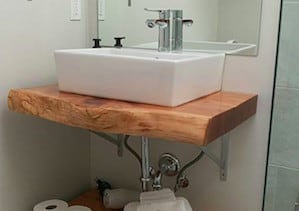
More and more I’m seeing thick solid slab wooden countertops.
This can be a good option if you can source a solid slab of wood.
They are typically thick, about 2 and a half inches. You can find the wood through a mill or local woodworking supplier.
This can be relatively inexpensive compared to other options. Especially if you do the installation and finishing yourself.
This example is in a bathroom, but I have seen this in kitchens as well.
You will want to use a very durable wood finish.
Butcher Block Counters

In butcher block countertops, the glues may or may not be tolerable for the chemically sensitive. Though most wood glues are very low in toxins.
They can be affordable.
Check to make sure it’s solid wood all the way through. IKEA butcher block countertops are affordable but they are not solid all the way through. The base is particleboard.
Home Depot carries a lot of solid wood butcher block slabs.
Tung oil is my top pick for a wood finish, as it’s a very durable natural finish. With citrus solvent it is food-safe.
Cost: $35 – $200 per square foot
This post is a deeper comparison of the most affordable non-toxic countertop options.
Tile Counters
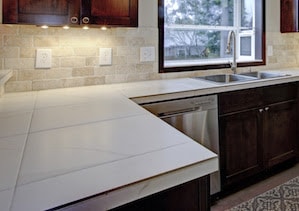
This is a good option that is chemically inert.
The challenge is that safe concrete-based grout is not what is normally used for a tile countertop. Because those grouts are so porous – it’s easy to get grime, food, and dust in the grout.
You could add a densifier and a sealer, and some chemically sensitive folks do use this method with concrete-based grout because it’s safe and inexpensive. A good non-toxic grout sealer is AFM Grout Sealer.
Tile works better as the backsplash.
Cost: $35 – $80 per square foot (if you don’t DIY)
Tadelakt Counters

Tadelakt counters are a unique and beautiful option that are totally natural and safe.
It generally should be a darker color because it is susceptible to staining and many use a wooden edge, as the plaster edge is vulnerable. It requires upkeep.
Here’s a really handy how-to for earthen countertops. Although it’s very labor-intensive, if you do it yourself it’s very affordable.
Laminate/Formica Counters
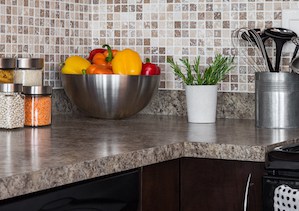
There is some misunderstanding on whether laminate is toxic.
The top layer of laminate is melamine plastic which is quite safe, but the melamine layer has a paper backing that does offgas formaldehyde.
I have not found the top layer inks to offgas, though you should get a sample of the brand you want to use.
The substrate that the melamine is glued down to is usually MDF which offgasses formaldehyde. It can also be plywood.
In lightweight trailers, the substrate can be polystyrene (EPS) foam. Even then, the problem can be in the contact cement glues used to hold these together.
There is another way. You can buy Formica sheets at Home Depot and attach them to the substrate of your choosing. You may put this over an existing laminate counter, over offgassed plywood, EPS foam on another substrate.
I tested this out – I offgassed the laminate, offgassed the plywood, had someone else glue them together, and then sealed them with shellac.
Although laminate does not look as upscale as many of the other options, it can look chic and modern in some of the new colors like solid black.
Some lines do include antimicrobials in the surface.
This DIY countertop is one of the most affordable options and can be low in toxins.
Cost: $20 to $50 per square foot
Tempered Glass Counters
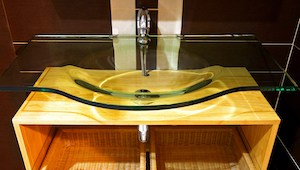
Tempered glass is costly and unusual but it is a very pure and totally inert option.
You are more likely to find this in a bathroom vanity top (with or without an integrated sink) than in a kitchen.
ThinkGlass makes custom glass kitchen countertops.
Construction Adhesive for Countertops
Silicone is most often used to attach countertops. My top pick of silicone type is neutral cure – oxime cure. Brands and where to buy there are listed here.
Almighty Adhesive is a construction adhesive that can be used to attach most countertops. Though it’s usually overkill in most cases. It’s extremely tolerable and very low in toxins.
In many cases you can attach the countertops mechanically, avoiding the use of glue.

Corinne Segura holds certificates in Building Biology, Healthier Materials and Sustainable Buildings, and more. She has 10 years of experience helping others create healthy homes.
Did you find this post helpful? If so you can buy me a coffee to support the research behind this blog. Thank you!

Hailee
Hi! I read your part in here about natural stone where you said it can off gas radon. You said that this won’t be in all natural stone. How do I find a natural stone that does not have this?
Thanks!
Corinne Segura, Building Biologist
Not all slabs of stone are radioactive, but I’m not sure if there is one type that never is.
Loralyn Sardella
Asking for help with wood conditioning info. I’m trying to condition the top of my Ikea Stenstorp Kitchen Island to even out an area that is stained from nut butter oil.
Ikea used to sell Skydd which is a white mineral oil for food prep surfaces (it’s clear mineral oil). They discontinued it despite good reviews and sold Stockyard (linseed and tung oil) and then most likely due to terrible revues and issues discontinued it too. They have nothing currently. They recommend a “non toxic oil for food prep”.
I’m considering a mineral oil from hardware store.
https://www.canadiantire.ca/…/watco-butcher-block-wood…
or
https://www.homedepot.ca/…/saman-clear…/1001027975
I already have some Life Brand Mineral Oil (Shoppers Drug Mart) which you can drink and saw a youtube vid with a woman using it on her cutting boards. Is there really a difference between these oils? I know there are different mineral oils, but the labels don’t say a lot. There are two pharmaceutical mineral oils, heavy and light. I have both because they sold me the wrong one. Using it would save me money especially since I need such a small amount. You can drink the heavy one and I’m wondering if this may suffice? Wondering if you could shed light on what would make these mineral oils different? Also any advice would be appreciated.
Corinne Segura, Building Biologist
Is the idea that you disguise the stain well enough to return it in two days?
What kind of oil did you spill? And was it pure oil?
Both of those links are food safe mineral oils, so both can be used on a butcher block. Im not certain they will disguise a spill of nut oil because the colors are different. Mineral oil does not have a tint to it and also is a temporary conditioner it does not polymerise and soak in the same way as linseed, tung and walnut oil.
it would be best to use something like walnut oil which has some color to i, however that will not cure in two days. it will also darken it a little, which will probably disguise whatever oil you spilled better but will not look as as much like the original wood color.
Im not positibe if mineral oil will look dry in two days either. Light mineral oil is what is used on wood as the heavy might be too sticky and not soak in as well but it might work. I don’t use mineral oil but have tested walnut, tung and linseed. You can test the mineral oil in th backside.
Loralyn Sardella
The stains are from leaking nut butter jars and yes pure oil. One was almond and the other macadamia nut. I didn’t realize the paper towel hadn’t absorbed it all and let them sit there a while. They darkened the wood a bit, so yes I thought if I oil the rest of it, I may be able to make it look less obvious and also brighten up the whole thing since you are meant to treat it occasionally. It does need to remain the same colour. I can’t make it too much darker. The top has lightened a bit over the years and I think the oil treatment is expected to make it richer and back to the darkness it started with so to speak. Most of it is perfect like new except for one area. I know this won’t totally disguise the stains, but may make them blend in a bit more with natural wood grain colour.
It doesn’t have to be dry in two days, but I have to be able to take pictures and have it look the way it will long term. If they accept my application the return date is unknown as of yet.
My understanding is food oils which are not heated will go rancid over time and that would ruin this item for the future owners. It is not normally recommended to use raw oils. Is there some sort of double boiled walnut oil? I didn’t see anything like that at Home Depot or Canadian Tire and I’m pretty limited to what I can get and apply in one day. Most of the walnut stains are too dark, but stain would be different from oil I assume? The top is a butcher block counter top, but no one would use it to cut food on. It is truly a table top so to speak. but it does need to be food safe and optional to use to cut on.
This product https://www.homedepot.ca/product/interbuild-hardwax-wood-oil-food-safe-voc-free-carbon-neutral-clear-250-ml/1001678719 was also recommended by Home Depot, but it confuses me. I think it may seal the wood which I don’t want as it’s meant to be periodically conditioned.
Corinne Segura, Building Biologist
i would go with walnut oil that is made for wood or linseed oil that is made for wood (and solvent free and ideally food safe). The nut oil stains are quite dark so i think you will need one of those oils to disguise it. Pure ideally. no stain. no wax as that adds sheen. the one you linked to has wax and also solvents that are slightly unpleasant.
Laura
What about Dolomite counters?
Corinne Segura, Building Biologist
needs to be sealed like the other light colored stones i talk about
Nancy
Hello!
Thank you so much for these articles!
What is the safest seal for a butcher block cutting table?
Thanks!
Corinne Segura, Building Biologist
i have some options listed out here https://www.mychemicalfreehouse.net/2020/10/the-7-most-affordable-non-toxic-countertops.html
Sarah
The house I bought has granite countertops in the kitchen. I’ve dreaded the prospect of re-sealing when the time comes. Water beads up on them, so I’m assuming there’s no need to reseal. However there are places where the stone was cut that are a bit ruddy due to the stone itself. I think it’s always been that way. Would you recommend I seal or does that just sound like how granite is? Not a big fan of granite, but it’s what I’m stuck with for now.
Corinne Segura
if it’s not at risk of being damanged then you dont need to seal it. also many very dark granites dont need a sealer at all. if the water does start soaking in the walnut oil is amazing.
Sarah
Thank you so much, Corinne! I’ve never used nut oils for fear of them going rancid. Is there a version to use for this kind of application that would avoid that? (PS Your new site is absolutely gorgeous! What a massive undertaking that must have been. But it was worth it. It’s beautiful! Congratulations!)
Corinne Segura
I’m glad you like the new design! the soapstone sealer in the post is fantastic ive tested it on so many things. just make sure if fully cures before you start washing it and it wont go rancid.
Bree H
Hi Corrine,
Great article, my builders are giving us three options for our new home cesar stone stone benches or laiminate through Laminex or Formica. Would cesarstone be the best option in low tox ness I get worried about it being silica but it’s safe when installed I keep reading ? Is it safer than laminate ? Thanks for sharing your info love your website so much
Corinne
cesarstone quartz is great and is not a risk when in place. safer than laminate in terms of offgassing.
CAROLE J ROSEN
Hi Corinne,
Thank you for the marvelous blogs and all of your amazing research. You are very much appreciated!
I am installing a Cambria countertop. My fabricator is using all green materials for installation which I found for him. However, I did ok an epoxy that Cambria makes (especially to match color of this countertop) which is Greenguard Gold and low VOC.
My question to you is that he wants to use denatured alcohol to clean the epoxy up and I don’t like the way that product sounds. Do you have any suggestions about what other product he could use to clean up the epoxy?. He said acetone can also be used but he felt that would be even worse. Do you agree that denatured alcohol is bad? If so, what can I give him to replace it? Thank you and awaiting your reply! Carole
Corinne
use alcohol it evaporates quickly
Tanya Waugh
hi! this research is unparalleled!
I’m looking into peel and stick counter top covers because I can’t get mine redone right away.
do you know of any with minimal to no off gassing? or can you recommend a sealant that would be ok to use over paper.
thanks!
Corinne
The peel and stick contact paper is always vinyl so I can’t recommend that. I suppose you could shellac over it which will yellow it and is also hard to put on evenly. I’m not sure if that’s a good idea (for durability as well). if you have laminate countertops consider using linseed oil paint to renew them (I talk about it on the site if you want more info).
Lisa
Curious about linoleum / marmoleum for countertop?
I know it will depend on adhesive but rehabbing a small cabin. Little area.
Also any info on CraftMade cabinets by Kenyon Noble? Some plywood in them.
Not KraftMade. Lowes / HD
Thanks
Corinne
I know some people use Furniture Linoleum (natural linoleum by Forbo) for countertops but it’s not really made for that and I don’t have experience with it. They say it’s for furniture applications such as desks, stools, cabinet fronts, doors and displays. The glue used with it is 0 VOC and water-based to should be fine. I wouldn’t consider that a very durable countertop but it sounds like it works for some people.
Caroline Smythe
What about using the floor marmoleum that has a protective sealer (Topshield2)? Sounds like it would hold up on a counter.
Corinne
You can use it on a countertop, I wouldn’t personally just because you can’t cut on it at all and I don’t think that’s very realistic. Topshield is a very thin clear coat on top.
Karlie Smith
Thanks for this list! I’m reading up to learn more about quartz for our kitchen. It’s nice to know that quartz countertops are non-toxic and safe for families, especially children.
Kara
Hello!! Do you worry about the talc in soapstone? For the asbestos? Thank you!
Corinne
No stone dust is safe to breath, takes precautions when cutting any stone, all is safe when in place as a countertop.
Merlyn James Yohannan
Thanks for all the valuable information. The underside of granite countertop is always dusty. Im concerned how to clean that. Do you have any suggestions. Thanks
Meredith
Is Caesarstone safe once installed or is there still a risk of silicosis? This is for a potential countertop in a laundry room. Thank you!
Corinne
safe when installed, only a risk when in dust form
Erica
What do you suggest for sealing a Quartz countertop?
Lou
The link to the concrete countertops with no fly ash is broken.
Corinne
The link works for me http://www.buddyrhodes.com/concrete-countertop-mix
Carmen
Hi Corinne,
I love your page and use it very often so thank you.
Do you have a recommendation for non toxic glue to attach laminate sheets to old laminate countertop?
thanks again!
Corinne
Ah contact adhesive, they are all toxic at first, it would be about finding which one cures fast. I haven’t tested across brands.
Monica
Hello!
Thank you for a very informative article! I have a question regarding solid surface. What is your opinion on Wilsonart? I noticed it wasn’t mentioned in the article.
Also, it has a UL GreenGuard Gold Certification. Do you know what this means and if it’s something to look for?
Thank you, again!
Corinne
I haven’t looked at that one but solid surface should always mean acrylic or polyester without ground up stone, with alumina. They are way way below the Green Guard Gold levels of VOCs so that certification is not useful here. A countertop at the upper levels of that certification would actually be quite unusual and I wouldn’t list something that high in offgassing here most likely since there are so many better options.
Jessica Pearlman
Hi Corinne
You say above that
“But most tile counters are not made with concrete grout. More toxic grouts are usually used in this application.” what kinds of toxic elements are in these grouts? VOCs? biocides? Other?
Thank you very much.
—Jessica
Corinne
VOCs
Universal Stone
Lots of good pointers here. I hope this post could help a lot of homeowners looking to buy new kitchen countertops!
Mandi
Hi Corrinne! The link to the concrete mix no longer works. What is the name of the brand? And also, I can’t find that AFM product to seal the concrete countertops. Do they still make that? Thanks so much!
Corinne
I updated that link. You have to contact GDC for that product.
Joanna
Hello. Do you know if the AFM Almighty can be used to do seams with granite instead of Epoxy? Do you know if silicone adhesive is needed to attach the granite to the cabinets. It is pushed by the contractor. is this really necessary when the counter is so heavy?
Thanks in advance.
Corinne
It’s not a replacement for epoxy. I would use silionce underneath but check out the video in the caulking post. Silicone is not too difficult to tolerate if you get the right one. It is possible to go without it, I have done it but you have to check the warranty implications. I cannot advise to do it but I did it….
Eli Richardson
I’m glad you talked about countertop materials and how to choose a non-toxic one. Recently, my wife and I decided we’d like to renovate our house. We’re excited to start with our kitchen, and since we want new countertops, we’re sure your article will help us choose the right material for us! Thanks for the information on how granite countertops are safe to use.
Joanna
Hello
I am looking for a natural sealer for marble or granite. I have read all your posts. I prefer to not use the synthetics despite being low VOC. Problem is my daughter is anaphylactic to walnuts so walnut oil is out. She is okay with almonds, macadamian nuts and hazelnuts. Could I use almond oil or olive oil? Would these go rancid?
Universal Stone
Great Post! Thanks for sharing this useful information!
Barb
Hi Corinne,
I need a sealer to go on a stone shelf that keeps oil stains off of the shelf. Suggestions? In Canada. Can’t get 511
Thankyou in advance
Corinne
Well I definitely wouldn’t use 511! I would use one of the sealers in this article, depending on the stone.
Barb
Thankyou for your reply. OIL is the culprit. Will any nontoxic sealers protect rock from oil?
Thankyou in advance.
Corinne
Yes, it depends on the stone here is my testing results of the natural oils on multiple stones https://www.mychemicalfreehouse.net/2020/08/natural-non-toxic-sealers-for-stone-countertops.html
kate
Is the JS Crystal Clear Cure & Seal for concrete a product you would recommend, it claims to be low VOC but i have struggled to find further information on it.
Corinne
It’s not low VOC, it’s is a solvent-based product with less than 350
g/L VOC’s. That’s pretty high!
Lesley
What are your recommendations for sealers to be used on polished granite or quartzite? As far as I can tell, you only mention sealers for unpolished stone. Thanks in advance!
Corinne
see articles on natural and synthetic stone sealers
Grace
It looks like Meta Creme changed its name to Waterborne Dense Stone Sealer. Do you know if the product is the same? I am looking to seal quartzite and tile in the kitchen and bathroom. Is this the best and most non-toxic I am going to get for a sealer? Should I be concerned about the MSDS about tests they did where they have a check next to Reproductivity? I think
meaning it can be harmful for that.
Corinne
I’ll ask them but usually it would say improved formula or something like that if it changed. Let’s see…
Diane
Do you have any suggestions on cabinets for kitchen and bath. I am looking at crystal cabinets ( painted ) and I read wood cabinets 4 less. Although unsure of who to go with. Any suggestions on this. Also if anyone has any experience with either companies with off gassing, especially if painted cabinets.
Nelly
For those of us who can’t remodel their kitchen counters, does a non-toxic “stick and peel” or counter top cover exist?
Anna
Ice Stone now includes a built in sealer. They said it was a new addition, to make it more convenient for the consumer (no more yearly sealing). They were not willing to share with me the ingredient details, as they said it is proprietary info. However, they did give me a generalized statement on it. May I share it with you? I am unsure if I should get their product because of the built in sealer.
Anna
Ice Stone now includes a built in sealer. They said it was a new addition, to make it more convenient diverge consumer (no more yearly sealing). They were not willing to share with me the ingredient details, as they said it is proprietary info. However, t get did give me a generalized statement on it. May I share it with you? I am unsure if I should get they product because of the built in sealer.
blindsandshutters
this is so beautiful! I love the color and how it goes with the pots and the succulents just give it that perfect mediterranean feeling! thanks for showing! :o)
Nhà Bếp Hoàng Gia
This article is really the one that I needed. I really learned a lot by reading the whole content. Thanks for this.
Maria Elena
Great work!
Unknown
Thanks for sharing!
Unknown
If you are looking at remodeling your kitchen and want to keep it safe without the chemicals and formaldehyde
JerryWalton
nice one….
Unknown
I have MCS and CFS and my big challenge is the range. I don't use gas ranges, but I struggle to find an electric oven that I can use without it making me very ill, with daily use for the first year. When I had to get a new one 5 years ago, I tried running it while I was out of the house, etc., but ended up giving it to a friend to off-gas. Hoping it will be okay now. Now in the market for a refrigerator, and not sure what to do. Don't have an outlet in the garage that can accommodate a fridge. Wish there were more options for people like us.
Corinne
A lot of people do the garage strategy. A small fridge using a regular plug.
Unknown
Hi Corinne, You wrote "The [faucets] I have seen that are 100% lead-free are made of 100% solid stainless steel." Since Parmir tested positive, do you have another lead free faucet recommendation that is reasonably priced? thanks!
Parmir claims to make 100% lead-free faucets but a client used these lead swabs to test a kitchen and bathroom faucet and the test proved positive.
The other options for 100% lead-free faucets are pricy. MGS an Italian company and Waterstone Faucets also make 100% stainless faucets. Another one I have seen is this one called Jerry.
Fern Lady
I am very chemically sensitive & need a new washer/dryer unit. Any recommendations or ideas?
Lindsay Craig
Hi Corrine, my husband and I have just purchased our first home and although I have not been tested for MCS I know I am very sensitive to inorganic chemicals and materials, as well as my son. I am not well versed in your area of expertise so I am trying my best to get a quick, as thorough as possible, education on these subjects as we are crunched for time.
We are redoing our floors in solid raw hardwood and was wondering your thoughts on Rubio Monocoat Oil Plus? We also are planning on doing a nail in installation but not sure what exactly is underneath the current floors. Seeing if we have to get soft plywood is there certain brands you would recommend? And considering we get the lowest VOC possible how long on average does it take for soft plywood to off gas?
Lastly, we are taking out the upper cabinets in the kitchen and putting in solid wood exposed shelving but plan to extend counter top space. I'm not sure what kind of cabinets are currently installed but its like there is a think plastic sticker covering the particle or what board underneath. We are wanting to just take them all out to not have to match these. So hopefully we can salvage some older off gassed cabinets, but if not I was wondering if you have any thoughts or knowledge on ikea cabinets considering they adhere to a higher standard than the US. I came across this option here: https://gimmethegoodstuff.org/non-toxic-kitchen-cabinets-for-project-one-eleven/
Any thoughts? I do plan on having an Austin Air to help with these two renovations.
Thank you so much for sharing your journey and knowledge with us all. You are very much appreciated.
Charles R Bailey Cabinetmakers
Using Ikea cabinetry is not exactly safe. As you have to deal with pressed board. That has formaldehyde and takes forever to outgass. If your looking for safe, formaldehyde free, chemical free cabinets check us out. We would love to talk to you and help you out on your cabinetry.
Corinne
Hi Lindsay, Yes there is certainly a lot of info to get through! A lot of this is talked about on the blog.
Bonnie B.
I am very sensitive to chemicals and may need a new refrigerator. Also, all of my family has died of cancers (my siblings in their 40s) and I have an autoimmune disease and asthma. What can be done to have a fridge that doesn't outgas a lot of plastic into the food in it? And are the compressors always smelly and need to be run ahead of installation? I read the tips listed above, but am wondering what other thoughts people might have for me. Any suggestions on a brand? (Also – we can't have a really small fridge as we need a family sized one.) Thanks much.
Corinne
I have heard conflicting things about which ones are better. You may find a floor model that has offgassed or leave it in the garage running for a bit. As for which brand or type is the best for offgassing there isn't much agreement, you have to sniff a few of them if you can stand the exposures. You would think stainless would be better but that's not what I have seen.
Charles R Bailey Cabinetmakers
Are you looking for custom, solid wood, formaldehyde free cabinets & furniture? We can build your custom project with chemical free woods & finishes.
Walsh Built Homes
I just stumbled upon this blog and wanted to share a cabinet line we use in our homes that is conscious of keeping the toxins out of kitchens. http://Www.walcraftcabinetry.com . hope this helps someone ;0)
Laurisa Rich
waste of time. I just went to your website and no mention is made of low-toxicity materials and no certifications.
Ana john
Don't waste your money on these pans. they work for a few weeks, but after that you'll be using more and more oil to keep food from sticking. Eventually even the oil won't help. One of the worst kitchen utensils I ever bought.
Corinne
Not sure what you are referring to!
Anonymous
I'm really chemically sensitive and am responding to my new Cambria kitchen countertops which were sprayed using a granite solution at installation. Does anybody have any ideas or recommendations?
http://classicquartzstone.com
Corinne
They should avoid spraying them with this cleaning product at installation. You will have to wash it off on sides where you can reach it.
scotty123
InovaStone has been providing quality natural stone worktops to individual and corporate consumers since 2000. Supplying you with just the best of service, our team are completely licensed to template worktops which they later on cut and polish in our work spaces, and finally return to match by the similar team.
Unknown
l
Looking for a non toxic utility sink. Anyone have any ideas? Is there any off gassing with a stainless steal sink? Didn't want that look but I can not find a utility sink that is not plastic. Porcelain will chip and is expensive.
Corinne
Stainless does not offgas but might have insulation underneath that does.
Jayeed Baq
Cambria Quartz in your tiny home and it's absolutely beautiful. Color combination of kitchen is really amazing. Thanks for this insightful article.
Kelly Bailey
I had a set of cabinets built for my home from a cabinetmaker in Flippin, AR. He made a gorgeous set of cabinets that were chemical free/formaldhyde free, all solid wood. When I got them delivered to my home I was really worried about smells, but when I got close to them and even sat next to them they didn't smell and there wasn't any off gassing of any kind. I've had my cabinets in my home now for about a year and still no problems. Love them!
Corinne
How far is their geographical range for kitchen and bathroom cabinets?
Kelly Bailey
nation wide
Alyssa
That is so weird. I am from there. Would you mind sharing their information?
Corinne
They are talking about their family member’s business: Charles Baily cabinets.
Unknown
How are you suppose to test for radioactivity & lead in the counter tops and in tiles etc? We are looking into buying a home and I am a little overwhelmed at all the crap in our environment and all the possible and probable contaminants. Its starting to seem impossible to buy a safe home and is almost starting to get to the point where we are just going to have to pick and choose what is absolutely necessary and what we can deal with.
Corinne
Granite you can test for radioactivity and glazed tiles for lead – if you want to be super careful.
K
Do you need to test Danby marble for radioactivity and/or radon?
Corinne
Many natural stones could have some radon but granite is the only one that is normally tested because it’s the one that could have “significant” levels. Though personally I wouldn’t test it if it was for myself because it’s not significant enough.
Bob Lowe
Great post. Lots of good information. A quartz counter top seem ideal for keeping things clean and not harboring bacteria. What exactly do they use to for a sealant and resin that would last a long time but also be toxic free. Does it last as long as normal sealant?
Mark W.
Great writing
Simon Upping
Thanks Corinne
Simon Upping
Hi I'm sourcing for furniture for my new home and am considering aluminium furniture. However I came across sites that says that aluminum is toxic. But aluminium makers said they are not. One said that their's is made from aluminium allow grade 6063-T5 and that its non-toxic. Can anyone clarify? Thanks very much for your help.
Corinne
Aluminum itself is not toxic. The paints on it may be. Powder-coated is best as it cures quickly and should be tolerable.
Corinne
Hi, that is about ingesting it or breathing in the dust.
Simon Upping
Thanks Corrine. I tried to google aluminium toxicity of furnishings but could not find any. What I discovered was warnings linked to cookware and foil and breathing in aluminium. Could there be a danger that since the aluminium furniture is a permanent fixture, we are breathing in aluminium? Thanks very much for your input.
Veronica George
What did you mean you didn't use glue to fasten your quartz countertop? How did you secure it?
Corinne
It is just sitting there. The sink holds it in place but it is heavy enough that it doesn't move. You can mechanically fasten it or silicone or AFM Almighty Adhesive.
Sue Houston
Lovely post.
Linda Rowe
I'm very chemically sensitive and am reacting to my new Cambria countertops that were sprayed with a granite cleaner at installation. I contacted Cambria USA and learned that the resin is polyester-based – I am highly sensitive to polyester! Does anyone have any thoughts or suggestions? We're currently looking at the granite cleaner and what would remove a possible residue. However, my reactions [respiratory and neurological] have me thinking the problem is the resin. I thought I would be good with these Greenguard counters, but so far is it not good.
Corinne
yeah, I caught them just as they were putting that cleaner on and we washed it thoroughly with vinegar outside before it was brought in. The cleaner smell should not have soaked in those as it is no porous. As I mentioned it did have a smell for the first few days. I would just give it a while and if that doesn't get better put it outside for a while. it will offgas
Corinne
Hi Linda, did the cambria quartz ever offgas enough for you?
Anonymous
Thanks for the article! I want to install Cambria in my kitchen but am concerned about what "glue" will be used for a seam. Also, I would like a glass backsplash but am not certain about the adhesive. I am VERY chemically sensitive. Can you advise how you handle the Cambria?
Corinne
Depending on which Cambria material it might not have seams.
Keri Smith
I've been playing with the idea of installing Marble or granite countertops in my kitchen. I agree that having a chemical free kitchen is important. Thanks for the article!
Anonymous
Hello,
What do you think about soapstone countertops and are you familiar with paperstone countertops?
Anonymous
Made from recycled paper. VOC free, food safe no radon. They are a good use for recycled material.
SYoungquist
Hello,
As you've done quite a bit of research, I was wondering if you had come across or had any thoughts on Columbia Forest Product's Purebond plywood for cabinets. Supposedly with it's soy binder, the off gassing and VOC's are not as much of a problem. I'm considering this for our cabinets (possibly with solid-wood faces) in our kitchen, and am looking for informed opinions. Thanks!
wowwnc
I love your blog!
Thank you for creating it to give help & hope to others.
Do you have recommendations (brand names) for small, low EMF refrigerators?
Much appreciation to you.
Corinne
Hi, I don't know that there is a low EMF refrigerator as the coils needed to cool it produce quite a lot of EMFs.
Anonymous
Is a gas stove really bad to have? Do you think running the hood fan,having a properly maintained range, opening a window and having lots of plants in the house, takes care of the fumes?
Corinne
If you have Chronic Fatigue or other chronic illness I would avoid it for sure. Or if you are at risk for autoimmune diseases. If you are building and have an option I would for sure choose electric.
Anonymous
Thanks for the reply.
Epoxy resins Services
Such a Great house and nice post.